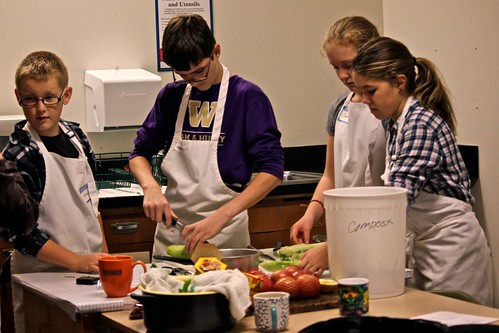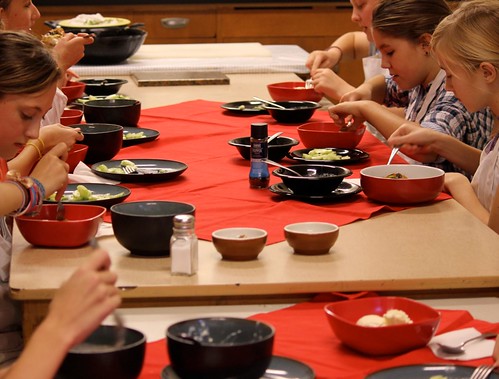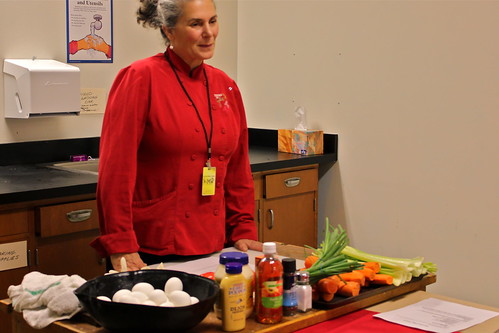In other words, great soup weather.
For this week's lesson, I wanted to practice timing recipes so that several dishes are served at the right temperature, while also introducing the kids to tempering, fat-oil ratios, emulsions, and (as always), cooking with mostly-organic, mostly-whole foods. We also needed some downtime to screen the "Nourish" documentary. (We'll hear more about that next week, with student volunteer "Professor Eric" leading the discussion.)
After checking in and washing up, we began our lesson with a snack of edamame, unsweetened mint tea, and a review of ingredients. The students discussed which foods were whole, which processed, and which could be grown locally (yes to cucumbers and mint and apples, no to lemons). We talked briefly about how to make broth of chicken bones from rotisserie or home-roasted chickens.
 Next we examined our recipes for prep times and determined that the cucumber salad, which needed to be chilled, would be our first point of attack.
Phyllis demonstrated decorative ways to peel cukes, and how to roll a lemon and slice it (horizontally) for the most juice. Our prep lead Matthew did a fine job with a sharp knife I brought from home (this prompted one student to say "only a teacher can bring knives to school!'). Two students donned gloves to dice a jalapeno, something I wish I'd learned at their age; it would have spared me a memorable pepper accident. (Children, never rub your eyes after touching peppers!)
Next we examined our recipes for prep times and determined that the cucumber salad, which needed to be chilled, would be our first point of attack.
Phyllis demonstrated decorative ways to peel cukes, and how to roll a lemon and slice it (horizontally) for the most juice. Our prep lead Matthew did a fine job with a sharp knife I brought from home (this prompted one student to say "only a teacher can bring knives to school!'). Two students donned gloves to dice a jalapeno, something I wish I'd learned at their age; it would have spared me a memorable pepper accident. (Children, never rub your eyes after touching peppers!)When it was time to dress the salad, I asked the crew why we should aim for a "three-to-one fat-to-acid ratio." Their stares made me realize I needed to backtrack. Because these kids are so mature, I forget they are not adults, with decades in the kitchen! (Later my tween would inform me that for most kids, fat is an insult, and acid means an illegal drug. Yikes.)
After I explained the terms, I asked how much olive oil we would need to get 3:1 fat to acid with one tablespoon of lemon juice. There were some wild guesses; none of them the correct. The clock was ticking, so I gave them the answer and decided to postpone the ratio lesson until I have some visual aids. The salad was seasoned (amid much laughter about whether it was oversalted) and put away to chill.
Half the class then began washing, splitting, and coring apples, using a horizontal cut—a clever way to get a secure base—demonstrated by Phyllis. Next came the chopping of the Mexican chocolate (which is admittedly a a highly-processed, sugary treat, but only one teaspoon is needed per serving, and it really makes the dish). The kids also figured out how to triple the recipe.
Under Mary's oversight, the rest of the class whisked eggs and measured broth and rice for the soup. Avgolemono is one of my kids' favorite dinners, and also happens to be a low-risk way to learn about tempering eggs (puddings are far less forgiving). It came together quickly, and no sooner was the soup simmering than the apples were ready for the oven.
That cooking takes time is the primary reason people give for not doing more of it, so I wanted to give our students the experience of creating a tasty "scratch" meal in less than an hour. As the apples went in the oven, they raced down the hall to watch a movie. When they returned thirty minutes later, there was hot soup, cold salad, and perfectly roasted apples to enjoy.
Having students lead different functions has been a great way to juggle responsibilities. Plating lead Emma adorned each dessert with mint as the soup was ladled out. Gratitude lead Chloe expressed thanks for the food and for the class. (I was pleased to see that everyone waited until soup and salad were served, and thanks given, before digging in.)
Unfortunately, KP (kitchen patrol aka dishwashing) lead Eliot discovered, as our two hours ended, that she was out of a job. How silly of me, in a lesson about timing meals, to short KP! I'm still learning. Next week will be better.
***
Recipes
Avgolemono (Egg Lemon Soup)
Adapted from Epicurious, this easy soup is delicious! It can be made even richer with homemade stock and mirepoix, fresh herbs, and shredded chicken.
Serves 6-8
- 2 quarts (8 cups) chicken broth
- 1/2 cup uncooked rice (or orzo)
- Salt and pepper to taste
- 6 eggs
- 6 tablespoons lemon juice (from 2 or more lemons)
- In a large saucepan, bring broth to a boil.
- Add the rice or orzo and cook until al dente (about 20 for rice, 7 for orzo). Reduce heat to low; simmer.
- Meanwhile, in a medium bowl, whisk eggs with lemon juice.
- Ladle about 1 cup of the hot broth into the egg-and-lemon mixture while whisking, to temper eggs.
- Add the mixture back to the simmering saucepan. Stir until the soup becomes opaque and thickens as the eggs cook, 1 to 2 minutes. Season with salt and pepper, and garnish with fresh dill, if desired. Enjoy!
***
Cool Cucumber Salad with Mint
Serves 8
- 4 large cucumbers, peeled, seeded and sliced in crescent moons
- 3 tablespoons olive oil
- 1 tablespoon lemon juice or vinegar
- 3 tablespoons fresh mint, chopped
- salt and pepper to taste
- 1 tablespoon minced hot pepper if desired
Mix all ingredients, adjust seasoning, and chill before serving.
***
Baked Apples with Mexican Chocolate
Adapted from Martha Stewart Living, this filling dessert can be varied with pecans and dried raisins or cranberries added with chocolate.
Serves 4 (half apple per serving)
- 2 medium apples
- 1 ounces Mexican chocolate, such as Ibarra, coarsely chopped
- 1/2 stick (4 tablespoons) unsalted butter
- 1/4 cup water
- Preheat oven to 400 degrees. Halve each apple lengthwise (north pole to south pole). Using a melon baller, scoop out seeds, forming a small crater in center of each half.
- Fill each crater with heaping teaspoon of chocolate. Cut half the butter into small pieces, and divide among apples, placing over chocolate.
- Place water and remaining butter in a baking dish. Place filled apples in dish. Bake until a paring knife inserted into apples meets no resistance, 20 to 30 minutes.
To serve, drizzle with juices.










